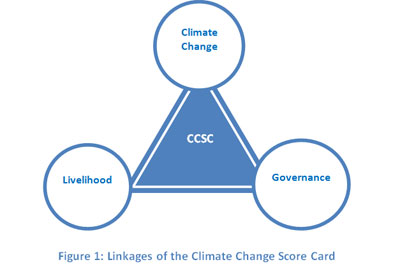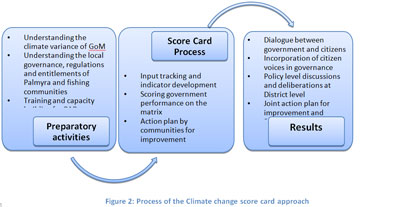|
|
Citizen Voices to Promote Environmental Governance: Towards an Equitable and Inclusive Development
Arvind L Sha & J Jangal
Environmental Governance is the means by which society determines and acts on goals and priorities related to the management of natural resources. This includes the rules, both formal and informal, that govern human behaviour in decision-making processes as well as the decisions themselves. Appropriate legal frameworks on the global, regional, national and local level are a prerequisite for good environmental governance.
The dawn of formal environmental governance in India can be traced to the mid-nineteenth century with legislative efforts to curb pollution. There have been several regulations enacted to control pollution, preserve natural resources and bio diversity in the country. Mechanisms have been created within this framework of regulation which gives opportunity for communities to participate. But are the local communities adequately equipped with knowledge and tools to be able to effectively contribute to decision making process for the enforcement of these regulations?
Participation has become a mantra in environmental governance. The usual arguments for participation include its positive contribution to the legitimacy and public acceptance of governance arrangements and outcomes; harnessing of local knowledge for substantive improvement of decisions and plans; resolution of political and societal conflicts by means of alternative mechanisms; and empowerment of marginalised groups who have been left out of environmental governance (e.g. Adger et al, 2003).
The rationale for understanding community participation is derived from Fiorino (1990) and Stirling (2006, 2008) and Blackstock and Richards (2007). This can be summarised into the following rationales:
• Instrumental - Effective participation makes decisions more legitimate and improves results.
It aims to restore public credibility, diffuse conflicts, justify decisions and limit future challenges to implementation by ‘creating ownership’. Policy goals are not open for discussion, only the details are (to a lesser or greater extent). It hereby supports incumbent interests.
• Substantive - Non-experts see problems, issues and solutions that experts miss.
It aims to increase the breadth and depth of information and thereby improve the quality of decisions; it ignores power issues e.g. related to problem framing. Unlike in the instrumental rationale, policy goals can be changed in a substantive rationale.
• Normative - Democratic ideals call for maximum participation.
It aims to counter the power of incumbent interests and allows all who are affected by a decision to have influence.
These three rationales have been widely used by proponents of participation to advocate inclusion of non-state actors in decision making. Typically, they are presented as if a participatory process can or should simultaneously yield benefits in all three, without consideration of potential contradictions between the arguments of each rationale.
Enhancing Community Centred Governance in Climate-Change affected Coastal Areas
A study initiated by Public Affairs Centre, in Gulf of Mannar region of Tamil Nadu in southern India were environmental concerns due to climate change and local human activity are significantly affecting the area’s ecological bio-sphere and the livelihoods of the poor that rely on it. People’s Action for Development (PAD), a local NGO which has been working with the coastal communities in in 117 villages, covering a population of about 60,000 in the districts of Ramanathapuram and Thoothukudi were the field partners.
Climate Change and Livelihoods in Gulf of Mannar
The livelihoods of Gulf of Mannar are under constant threat of changing climate in the sea and on land. The predominant livelihoods of the region are:
• Fishing and related livelihoods:Fishing is one of the main livelihoods of the region. In case of a family that is engaged in fishing as a main livelihood, the men in the family are mostly engaged in fishing and women are engaged in marketing the fish catch and in other fishing related activities like dry fish making, sea weed collection etc. Apart from this, women are also mostly engaged in mat making using coconut leaves and palm leaves.
• Palmyra Tapping: The Palmyra trees are commonly seen as clumps and rows on the edges of fields, lakes and sometimes dividing contiguous land patches. Palmyra related livelihoods form one of the main livelihoods of the people in the region. There are three main activities related to Palmyra that is seen widely practiced in this area. Tapping the palm juice or ‘Neera’ which is mostly done by men, making jiggery out of the use called the ‘Palmgur’ mostly by the women in the family and making mats, screens etc., out of palm leaves also mostly done by women of the family.
These livelihoods are being faced with the vagaries of climate change in the form of reduced fish catch, reduction in the number of families engaged in fishing by 50% by 2020, reduced palm production, increase in cost of continuing the traditional methods, shift in livelihood practices of sea shell collection to making ornaments by 12% by the year 2020 and migration of younger generation. These changes in livelihoods have led them to be in perpetual debt and have increased their vulnerability to the impending changes of climate.
Analysis of climate data of the region as provided by the Indian Meteorological Department for the past 104 years (1900 to 2004) have shown that there is an increase in the average temperature of the region after 1971 is on the rise exponentially and is estimated to be at the rate of 2.26±0.56oC per 100 years. The rainfall analysis of the region show that there is an increased variation in the frequency of rainfall. This was backed by the community as they said that the number of rainy days have reduced but the amount of rainfall has remanied the same.
Methodology
Climate Change Score Card (CCSC) is an adaptation of the Community Score Cards (CSC), a well-known social accountability tool (Sekhar and Nair 2008c, NRHM 2000). CSC consolidates people’s opinion and facilitates an informed dialogue between communities and the local governance structures. Conventionally, a CSC aims to bridge the dialogue between two main actors: the people and the state. In the case of climate change there are not two, but three important dimensions: the people, the state and the environment. To account for this, systematic integration of information on local governance and local climate science and livelihoods was made in the CCSC. The CCSC supports communities to prioritize issues and provides a platform for dialogue with relevant decision makers.

The entire approach of assessing the impact of climate change and formulating adaptation methods is founded upon the following strategic principles:
• Knowledge Creation: Knowledge is power, hence the generation of people’s knowledge through Climate Change Score Cards will empower communities to dialogue effectively with governance structures
• Empowerment: The knowledge generated through the CCSC and through secondary sources of information will enable the community to monitor the impact of environment and climate change on their lives. This will result in a more informed and empowered community.
• Constructive and meaningful engagement for policy influence: Constructive engagement with governance structures at different levels is achieved through dialogue. This is supported by the creation of action platforms that connect communities with informed and motivated government representatives
The Climate Change Score Card consists of four significant steps:
• Input tracking by the community: The input tracking exercise involved the consolidation of community knowledge on livelihood issues, and the role that climate change has played in exacerbating these issues as well as initiatives from the government to address these issues in this context. Seven participatory rural appraisal (PRA) tools were used to gather information on lives, livelihoods and the impact of climate change as perceived by the community.
The PRA exercises carried out gave insights on the following aspects of fishing and Palmyra livelihoods.
•Primary Season
•Ideal climatic conditions for carrying out the activity
.
• Perceptions on change (s) in the climate .
• Effects of these changes .
• Perception on local governance
• Adaptation / coping strategies by the community
• Scoring by the community:Representatives from the livelihood communities were asked to score a set of indicators developed through the input tracking exercise.
• Action plan by livelihood community representatives: Action plan was prepared by key community representatives and those who participated
• Interface meeting bringing together all stakeholders: to provide an an action platform that connects communities with the rest of the stakeholder groups (Community Representatives, Government officials, CBOs, worker’s unions, research organizations etc.) giving an opportunity for both parties to discuss the issues and arrive at suggestions that are acceptable by all stakeholders.

Outcomes of the Climate Change Score Card
• CCSC has tried to shift the attention from the global to local. It is playing a crucial role in elevating local strategies of adaptation and survival into the framework of governance by building local capacity in engaging with government
• The process of conducting the score card exercise facilitates constructive engagement between informed communities and service providers to find solutions to existing as well as emerging challenges.
• CCSC is a tool to capacitate and educate the beneficiaries to assess and evaluate the performance of the government. By participating in the process, they have begun to realize the intricacies of climate change, of governmental schemes designed to cater to their specific needs and related entitlements.
• Interactions have also been rewarding in terms of their willingness to extend support to the initiative and engage with the communities to arrive at effective solutions.
• The interface meeting held resulted in organizing a formal discussion forum at a regular frequency that facilitates greater transparency between the government and the citizens. The authorities were willing to share and discuss the nature of their work and services with the communities on a regular basis.
• CCSC has the potential of securing increased representation of local voices within dominant spheres of decision making. The local communities have, for the first time, participated in a process facilitating direct engagement with the government and its activities.
Conclusion
The Climate Change Score Card approach goes beyond being a tool to measure the quality of service delivery or accountability. It stimulates and supports a larger process of developing a culture of constructive engagement toward achieving accountability. The aim of the initiative is to extend support to the government and strengthen its efforts to reach out to its citizens more effectively and improve the existing system of service delivery. The conjugation of people’s knowledge and experience with administrative capability of government officials makes for a powerful case to higher level officers to consider altering legislation and regulations that are more sensitive to the quickly changing ground situations caused by climate change effects.
The study has developed the capacities of the local communities in two significant ways. First, by enhancing their awareness about their entitlements and on impacts of the changing environment on their livelihoods, it has heightened the need for communities to adapt to these changes wisely. Second, the CCSC exercise has provided an opportunity and means to translate this knowledge into informed collective action for an improved system of governance.
For more details write to us at: greengovernance@pacindia.org or visit our website www.pacindia.org

|